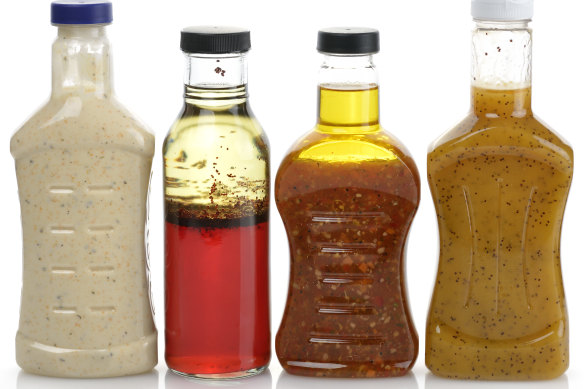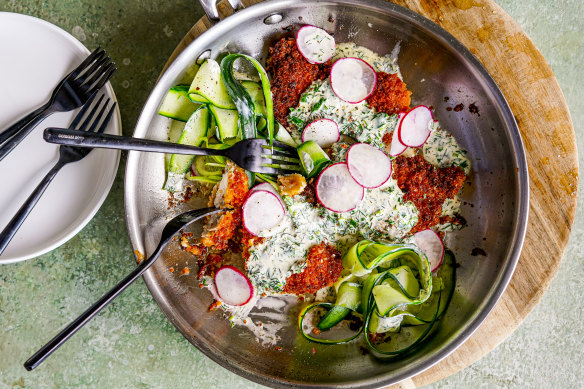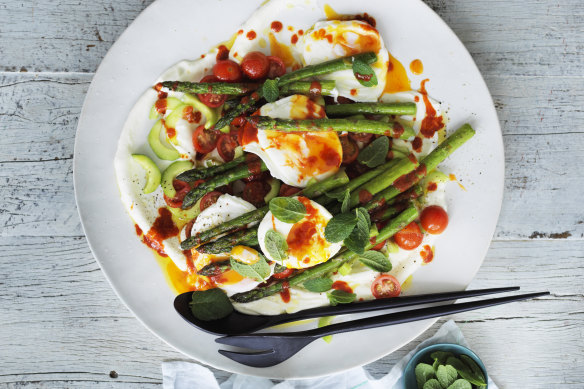10 popular salad dressings, ranked from unhealthiest to healthiest
A good dressing can be the difference between a delicious or not-so-tasty salad. But which are the best from a nutrition point of view?
It’s salad season, and it could be argued that a salad is incomplete until it is teamed with a delicious dressing to complement any mix of chopped vegetables.
While there is almost an entire supermarket aisle dedicated to dressings and sauces, the reality is that it can be tricky to find a ready-made dressing that is a good choice nutritionally, as most commercial dressings are a mix of vegetable oil and processed ingredients, which only really add refined fats and calories to the diet.
In saying that, there are a handful of good options that will not only improve the flavour profile of your favourite salad but optimise nutrient absorption of the salad ingredients you are enjoying.
Here are some common salad dressings, ranked from the unhealthiest to healthiest.

Kewpie mayonnaise
For many a mayo lover, if it’s not Kewpie mayo, then it’s not mayo. Unlike traditional mayonnaise, Kewpie is made using only the yolk of the eggs, which gives it a rich taste, colour and texture. It could be argued that home-made varieties are healthier, as they contain no added sugar. Often, supermarket varieties are heavily processed, contain a lower percentage of egg yolk, and may contain added MSG or flavour enhancer 621, which give brands such as Kewpie their moreish flavour.
Mayonnaise
A popular spread, sauce and salad dressing, mayonnaise is a food product we can feel passionate about, but the nutritional reality is that traditional mayonnaise is extremely high in fat and can pack a serious calorie and fat punch when it is added liberally to creamy salads. While there are some differences among brands, with a base of 70 per cent vegetable oil and between 7-9 per cent whole egg, a regular mayonnaise contains upwards of 70 per cent fat, or more than 10g of fat per tablespoon, meaning you may want to watch your portions even if you love it.
Caesar
Just as a caesar salad masquerades as a somewhat healthy dish, so too can the dressing. In its purest home-made form with a base of mayonnaise, mustard, garlic and lemon, a little of any dressing is no major cause for concern. On the other hand, commercially bottled caesar dressings tend to be made with a base of processed vegetable oil and a long list of refined ingredients, which means you are much better off making your own if a caesar salad is your thing.

Ranch
Ranch dressing is popular in the US, where it is frequently served with fried foods and in creamy salads, so it may come as a surprise to hear that the mix of mayonnaise, sour cream, lemon juice and a range of herbs and spices is lower in fat than mayonnaise, which makes ranch a lighter, creamy salad dressing option. While you can find low-fat varieties of ranch in supermarkets, they are usually heavily processed with a vegetable oil base, which means you are much better making your own if creamy dressings are what you’re after.
Pesto
If you make your own, this simple mix of basil, nuts, parmesan, garlic and extra virgin olive oil is a calorie-dense yet nutritious accompaniment for salad or vegetables. On the other hand, the fat content of commercial brands of pesto differs significantly, ranging from 20-50 per cent depending on the amounts of oil and nuts used. As a general rule, the fewer the ingredients, and the higher the proportion of basil, the better. Better yet, if you can find a commercial pesto made with extra virgin olive oil, it will be a much better option nutritionally.
Green goddess
Versions of the green goddess salad have been around for many years. Essentially, it’s a range of green vegetables enjoyed with a slightly tangy mix of mayo or Greek yoghurt, herbs, garlic and lemon juice. In the world of nutrition, the obsession with all ingredients green and healthy has prompted a green goddess comeback recently. The good news is that it is relatively easy to make a healthy version of green goddess dressing if you opt for lighter ingredients such as Greek yoghurt instead of mayonnaise, and extra virgin olive oil rather than vegetable oil. Most commercial supermarket varieties are high in fat, however, and use vegetable oil as the base ingredient.
Miso sesame
As the range of cuisines regularly enjoyed on the weekly meal roster expands, so too does the range of seasonings we can use in our home cooking. You can now find many mixed Asian dressings to flavour meals, including the popular miso sesame. The good news is that, unlike traditional creamy salad dressings, these options tend to be much lighter, and are often made without a base of processed vegetable oil. While they do contain more added salt than oil-based dressings, nutritionally they are a much healthier, lower-calorie option. They’re easy to make at home with signature flavour-rich ingredients too, but if you do find it easier to buy pre-made dressings, scan the labels for ones that have a base of soy and water rather than oil.

Sriracha
If you like things hot, there are plenty of Sriracha dressings you can add to flavour anything from salads to pasta sauces. In its purest form, Sriracha is a simple mix of loads of chilli, red peppers and a little salt and sugar to create a flavour sensation with few calories. There are also plenty of pre-made dressing options in supermarkets. But check ingredient lists as these tend to be much higher in sugars than home-made options, and can add 2-3 teaspoons of sugar per serve.
Apple cider vinegar
If you are interested in blood glucose control, you may have been persuaded to try apple cider vinegar as both a general dietary addition and as a zesty salad dressing. A fermented product that contains little other than a small amount of carbohydrate, apple cider vinegar works well teamed with extra virgin olive oil, and creates a flavourful, relatively low-calorie salad dressing that may support glucose control.
Balsamic vinegar
If you were rating the healthiest salad dressing, you would be hard-pushed to find a better mix than extra virgin olive oil teamed with a little balsamic vinegar. It’s low in sugars, and adds antioxidants and good fats into the diet – there’s a reason those from the Mediterranean who live long keep their salad dressings simple. While balsamic vinegar on its own is a good choice, be aware that the commonly used balsamic glazes can be extremely high in sugars. Stick to balsamic vinegar when mixing healthy dressings at home.
A lighter, creamy dressing to make at home
This mix of lighter dairy, vinegar and vegetables creates a tasty, yet light salad dressing that has the richness and flavour of a higher-fat, traditional creamy dressing.
INGREDIENTS
- ¼ cup sun-dried tomatoes, drained
- ½ cup reduced-fat milk
- ½ cup light sour cream
- 1 garlic clove, crushed
- 2 tsp balsamic vinegar
- 1 tsp oregano
METHOD
- Place the ingredients into a blender and blend until smooth. It will keep in the fridge for up to four days.
Serves 2-3
The best recipes from Australia's leading chefs straight to your inbox.
Sign up